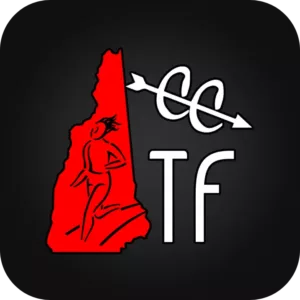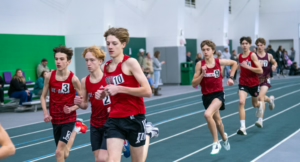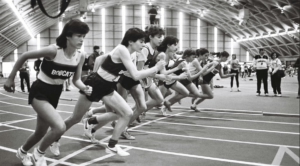By Mike Smith
This is not a book review. I don’t profess to be a running guru. I don’t belong to any book clubs, nor am I qualified to review books even if they are about a topic I love. Far from it.
But as a coach, runner and running fanatic, I read a LOT of books on running. Some are about the process of training, some are journals of individuals and teams over the span of a season or career, and some are simply about running in general.
My most recent book is “Running to the Edge: A Band of Misfits and the Guru Who Unlocked the Secrets of Speed“ by Matthew  Futterman. It’s the story of Bob Larsen, a guy who ran back in the early days before training for running became a thing. Larsen coached Meb Keflezighi, Olympic silver medalist and winner of the 2014 (post bombing) Boston Marathon becoming the first American to win it since 1983.
Futterman. It’s the story of Bob Larsen, a guy who ran back in the early days before training for running became a thing. Larsen coached Meb Keflezighi, Olympic silver medalist and winner of the 2014 (post bombing) Boston Marathon becoming the first American to win it since 1983.
Penguin Random House Books previews the book by saying:
Visionary American running coach Bob Larsen assembled a mismatched team of elite California runners . . . the start of his decades-long quest for championships, Olympic glory, and pursuit of “the epic run.”
In the dusty hills above San Diego, Bob Larsen became America’s greatest running coach. Starting with a ragtag group of high school cross country and track runners, Larsen set out on a decades-long quest to find the secret of running impossibly fast, for longer distances than anyone thought possible. Himself a former farm boy who fell into his track career by accident, Larsen worked through coaching high school, junior college, and college, coaxing talented runners away from more traditional sports as the running craze was in its infancy in the 60’s and 70’s. On the arid trails and windy roads of California, Larsen relentlessly sought the ‘secret sauce’ of speed and endurance that would catapult American running onto the national stage.
Now Bob Larsen might not be a household name like Alberto Salazar, Jerry Schumacher or Mike Smith (not me – the Northern Arizona coach) but his and Joe Vigil’s contribution to endurance athletics, with altitude training and the tenants of threshold training, Larsen is the unheralded savior of endurance running that brought the sport out of the shadows in the late 1990’s/early 2000’s where coaches had turned away from mileage and turned inward towards intervals.
Anyway, the book is a solid read, and provides an interesting background to reemergence of American distance running, even if it is through one perspective. At 304 pages it gets a little long, but worth the time and effort if reading about running is your sort of thing.
But along with this look back into the return to putting the distance in distance running, I did find two nuggets of thought that really struck me. The first was in regard to the relentless usage of intervals on the track that was the mainstay of training back before Larsen and Bill Bowerman.
 “It’s a strange thing about a track. There is something about those eight lanes and that quarter mile oval, the scattering of the curiosity seekers who always seem to pause as they wander by. From the first moment a spike hits the dirt (or the cinders, or eventually the rubber) a runner on a track wants to be great in that moment. He wants to win every lap, every interval, wants the stopwatch to always read a split second less than it did the lap before. The best runners crave competition, no matter who it is- a rival or a teammate – to be one step farther ahead or one step closer to the front than the previous day. But do that on a track day after day, month after month, and the breakdown will come.”
“It’s a strange thing about a track. There is something about those eight lanes and that quarter mile oval, the scattering of the curiosity seekers who always seem to pause as they wander by. From the first moment a spike hits the dirt (or the cinders, or eventually the rubber) a runner on a track wants to be great in that moment. He wants to win every lap, every interval, wants the stopwatch to always read a split second less than it did the lap before. The best runners crave competition, no matter who it is- a rival or a teammate – to be one step farther ahead or one step closer to the front than the previous day. But do that on a track day after day, month after month, and the breakdown will come.”
I feel some of the magic of the track as black magic. It becomes too easy to overtrain on a track. The athlete wants to win every lap, making sure that they are never over the pace time, always under. The track, whether used for a workout or for some competitive use, is always a race. Use the track too much and the athlete is headed straight for the injury heap.
The second gem is about distance races.
“It’s a funny thing about these long running races. The start and the route to the finish and the finish line itself are so clear. And yet each one feels like a mysterious journey, each mile bringing another surprise.”
It’s easy to discern certain things in the longer races There is a definite start and a definite finish. But it’s the journey that’s the mystery. That’s not the case in a sprint. In a sprint, the gun goes off and the race is over. There is no journey. The magic of distance races is in the journey; how the story plays out in the time between the start and the finish. How anyone can simply watch a cross country race standing at the start and finish is beyond me. They’re missing pretty much everything. The story is in the rest of the race.
In some ways I feel my journey as a coach is a distant reflection of Larsen’s. Disheartened by track work as an athlete and later as a “newb” coach (mostly because of the state of our track!), I learned to embrace the hard work that intentionally doesn’t happen on a track. I believe one of the strengths of our program is the absence of an all weather track. I’ve learned that in our sport, the essence can be lost in the metrics of the race, in the place of time that the athlete achieves. What we need to strive for is the magic of the journey, where that takes us, and what we learn about ourselves in the process. That is the magic and the meaning of our sport.












2 Responses
Nicely done, Mike. Keep sharing your insights within the context of some of the great running books out there.
Got two in the hopper now. 26 Marathons by Meb, chronicling each of his 26 marathons run, and Inside a Marathon by and about Scott Fauble and Ben Rosario training for Fauble’s 6th place at NYC. I’ll let you how they go!